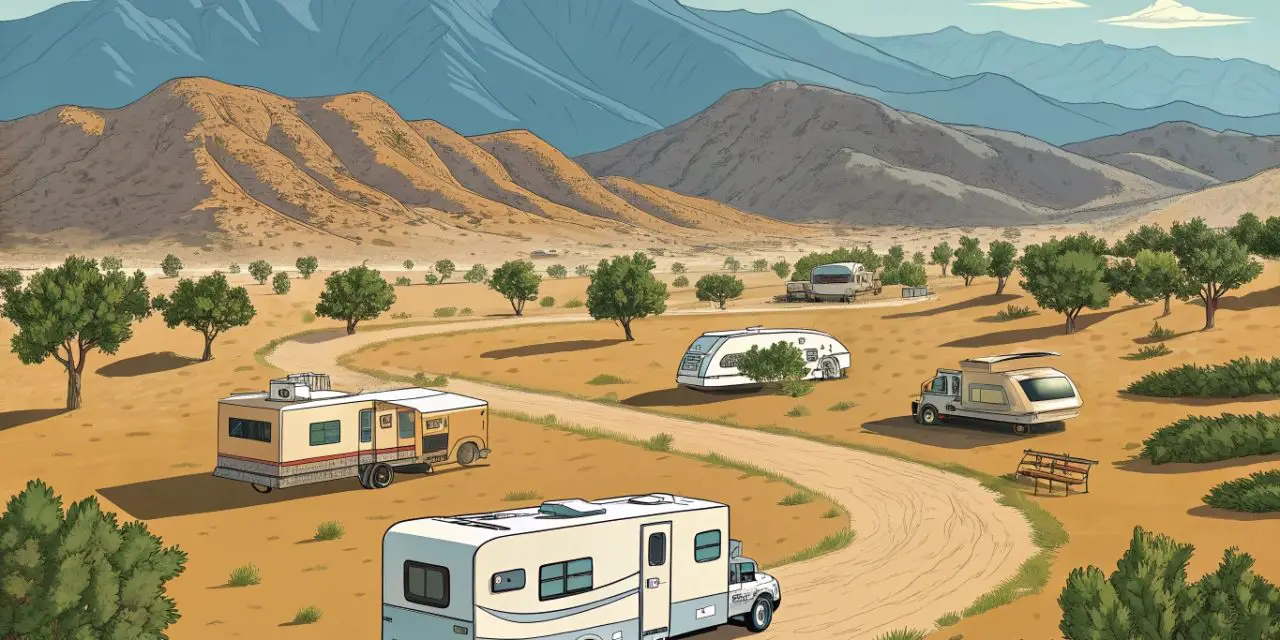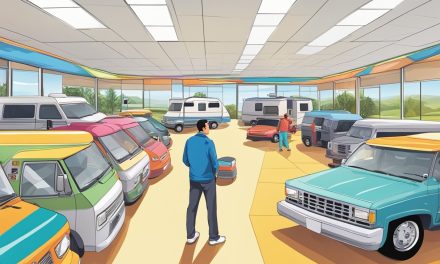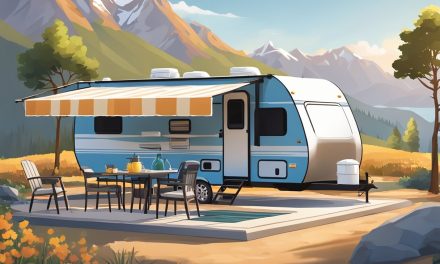Would you like to save this article?
You’ve seen those perfect Instagram shots of RVs nestled against stunning mountain backdrops, but you’re probably wondering: “Is boondocking actually safe, or are these RV show-offs just pretending everything’s peachy?”
Well, grab your camping chair and settle in, because we’re about to spill the real tea on staying safe while camping off-grid. After analyzing real boondocking experiences and diving deep into safety statistics, here are the 7 crucial safety secrets that separate the smart campers from the sorry ones.
1. The Research Game-Changer: Read Reviews Like Your Life Depends On It
You wouldn’t buy a car without reading reviews, so why would you park your home-on-wheels somewhere without doing the same? The first safety secret that experienced boondockers swear by is thorough research using apps like Campendium, iOverlander, and AllStays.
Smart RVers look for these red flags in reviews:
- Reports of homeless encampments nearby
- Mentions of weekend party crowds
- Complaints about trash or human waste
- Stories about aggressive locals or sketchy behavior
What good reviews should tell you:
- “Felt safe, would stay again” – This phrase appeared in multiple Sacred White Shell Mountain reviews
- Details about road conditions for big rigs
- Information about cell service availability
- Notes about spacing between campsites
| Review Red Flags | Green Light Indicators |
|---|---|
| “Sketchy people around” | “Family-friendly atmosphere” |
| “Lots of trash everywhere” | “Clean, well-maintained area” |
| “Loud parties at night” | “Quiet and peaceful” |
| “Felt unsafe after dark” | “Great for solo travelers” |
Here’s your funny reality check: You’re basically becoming a camping detective, and honestly, you’re probably better at investigating campgrounds than most people are at choosing Netflix shows. At least when you pick a bad camping spot, you can just drive away – unlike that 8-hour documentary series you committed to watching.
2. Trust Your Gut (It’s Smarter Than You Think)
Your intuition isn’t just some woo-woo concept – it’s actually your brain processing subtle danger signals faster than your conscious mind can catch up. Experienced boondockers have learned this lesson the hard way, and now they never ignore that little voice saying “something’s not right here.”
Real examples of gut feelings in action:
- Phoenix, Arizona incident: RVers felt uneasy about a new spot but stayed anyway. Within 2 days, someone detonated a quarter stick of dynamite within 100 yards of their RV.
- Northern Alabama mystery: Dozens of towable RVs with no vehicles in sight and no people around – the couple moved on immediately.
According to safety experts and crime statistics, your odds of being a crime victim while camping are roughly 1 in several thousand. But those who trust their instincts and move when something feels off? Their odds get even better.
Statistical Reality Check:
- Homicides dropped by 16% in 2024 compared to 2023
- Violent crime overall decreased by 10.3%
- Property crime fell by 13.1%
- RV theft is uncommon and rarely happens at campgrounds
Your gut-check reality: You’ve probably had more accurate hunches about which gas station bathroom to avoid than you realize. That same internal warning system works for campsites too – and unlike choosing the wrong restroom, listening to your camping instincts could literally save your vacation (and possibly more).
3. The Eyeball Factor: Fewer People = Safer Camping
Here’s a counterintuitive truth that shocks most newcomers: you’re often safer in the middle of nowhere than in a crowded campground. It’s all about the numbers game – the fewer eyeballs on your stuff, the lower your risk becomes.
Why boondocking is statistically safer:
- RV parks have higher crime rates than remote camping areas
- Criminals target areas with more potential victims and escape routes
- Campgrounds create “shopping opportunities” for thieves to scope out valuable gear
- Remote areas deter opportunistic criminals who prefer easy access and quick getaways
The numbers don’t lie:
- Statistics show more thefts, burglaries, vandalism, fights, attacks, and murders occur in RV parks and developed campgrounds than in remote boondocking areas
- Most RV thefts don’t happen at campgrounds – they occur in parking lots and residential areas
- You’re more likely to be victimized at a Walmart overnight than camping in a forest or desert
| Campground Type | Risk Level | Why |
|---|---|---|
| Remote Boondocking | Lowest | Few people, natural barriers, difficult access for criminals |
| Developed Campgrounds | Medium | More people but organized, some security presence |
| Urban RV Parks | Higher | Easy access, transient population, nearby urban crime |
| Walmart/Truck Stops | Highest | No security, high traffic, crime of opportunity |
Your reality check moment: You’re basically choosing between being a fish in a small, remote pond versus swimming in a crowded public pool. Sure, the remote pond might have fewer lifeguards, but it also has way fewer sharks. Plus, the only thing likely to steal your stuff in the wilderness is a raccoon, and they usually just want your Oreos.
4. The Ninja Rule: Keep Your Treasures Hidden
Out of sight, out of mind isn’t just good advice for avoiding your ex on social media – it’s the golden rule of RV security. Smart boondockers know that visible valuables are like neon signs advertising “Rob Me First!”
What to keep hidden:
- E-bikes and expensive outdoor gear – Use covers or store inside
- Generators – Keep in locked compartments when not in use
- Tools and equipment – Never leave visible in truck beds
- Electronics and cameras – Close blinds and window coverings
- Expensive camping chairs and tables – Put away when leaving site
The tonneau cover game-changer: A truck bed cover transforms your pickup from “mobile pawn shop display” to “nothing to see here, folks.” It hides everything from generators to expensive hitches, and bonus points – you won’t look like you’re living out of your truck.
Pro tip from the video: Put your Starlink dish on the roof when boondocking. It’s harder to steal, less visible, and serves as a cow-chewing deterrent (yes, that’s apparently a real thing).
Your “hiding stuff” reality check: You’re essentially playing the world’s most boring game of hide-and-seek, where the seekers might want to steal your stuff instead of just tagging you. The good news? You’re way better at this game than you were as a kid, and the stakes are just your camping gear instead of your dignity.
5. The Fort Knox Method: Lock Everything That Moves (And Some Things That Don’t)
If it’s not bolted down, locked up, or too heavy to carry, someone might decide it needs a new home. The most obvious safety tip is often the most overlooked – secure everything, including your RV itself.
Essential locking checklist:
- Truck/tow vehicle – Always locked, even at remote sites
- RV entry doors – Upgrade to keyless entry systems for better security
- External storage compartments – Individual locks for each bay
- Bikes and outdoor equipment – Chain and lock to RV or secure structure
- Generator – Use heavy chains or store in locked compartment
Why keyless RV locks matter: Most RV locks use just one or two key patterns industry-wide. Your “secure” RV might be openable by thousands of other RV keys. Keyless entry systems eliminate this vulnerability.
The “stupid criminal” defense: These security measures won’t stop determined thieves, but they’ll absolutely deter crimes of opportunity. Most RV crimes are impulsive, not planned heists.
| Security Level | What It Stops | Cost |
|---|---|---|
| Basic (Standard locks) | Opportunistic kids, casual theft | $0-50 |
| Intermediate (Upgraded locks, covers) | Most casual criminals | $100-300 |
| Advanced (Alarms, cameras, GPS) | All but determined professionals | $500+ |
Your security reality check: You’re not preparing for Ocean’s Eleven here – you’re just making your stuff less appealing than the unlocked RV three sites over. Think of it as camping natural selection: make yourself a harder target, and criminals will naturally evolve toward easier prey.
6. The “Find My Body” Protocol: Location Sharing Isn’t Just for Teenagers
This safety tip sounds morbid, but it’s absolutely crucial: Always tell someone exactly where you’re camping, especially when boondocking in remote areas. As one experienced RVer puts it, “This isn’t to prevent you from getting murdered – if that’s necessary, you’re already dead. This is so police can identify your body.”
How to share your location properly:
- Open Google Maps on your phone
- Press and hold your current location to drop a pin
- Click “Share” and copy the link
- Text the coordinates to a trusted family member or friend
- Set check-in schedules – daily or every few days
Why this matters for safety:
- Remote areas have no addresses – “somewhere near Great Sand Dunes” isn’t helpful for rescue teams
- Cell service may be spotty – family needs to know when to worry
- Emergency responders need exact coordinates for welfare checks
- Time is critical in real emergencies
The 72-hour rule: If your designated contact doesn’t hear from you within your agreed timeframe, they have the information needed to request a welfare check from local authorities.
Your morbid-but-practical reality check: You’re basically creating a “just in case” insurance policy that costs nothing but could save everything. It’s like leaving breadcrumbs, except instead of birds eating them, you’re making sure someone knows where to find your breadcrumbs if needed. Plus, your mom will appreciate knowing you’re not just “somewhere in Colorado being eaten by bears.”
7. The Weather Wild Card: Nature Doesn’t Care About Your Vacation Plans
While you’re busy worrying about human threats, Mother Nature is plotting to remind you who’s really in charge. Weather-related dangers often pose bigger risks to boondockers than any criminal activity.
Weather safety essentials:
- Check forecasts religiously – especially for flash flood warnings
- Understand your escape routes – muddy roads can trap you for days
- Carry emergency supplies – extra food, water, and warmth
- Know when to bail – that perfect sunset isn’t worth getting stuck
Real dangers you should actually worry about:
- Flash floods in desert washes and low-lying areas
- Sudden temperature drops at high elevation
- Wind storms that can damage RVs and topple trees
- Lightning strikes in exposed areas
- Snow/ice that can make roads impassable
The Sacred White Shell Mountain example: The video shows RVers dealing with muddy, slippery conditions after rain. Two-wheel-drive vehicles would have been stuck for days.
Your nature reality check: You’re essentially playing a strategic board game where the weather is that friend who keeps changing the rules mid-game. The difference is, when nature wins, you don’t just lose game night – you might lose your weekend, your RV’s undercarriage, or your dignity as you explain to your insurance company why you tried to drive through that “small” stream.
The Bottom Line: Smart Camping Beats Scared Camping Every Time
The truth about RV boondocking safety isn’t found in dramatic YouTube thumbnails or fear-mongering social media posts. It’s found in statistics, preparation, and common sense.
According to crime experts and RV safety data:
- You’re statistically safer camping than you are at home
- Boondocking has lower crime rates than developed campgrounds
- Most RV “incidents” involve weather, mechanical issues, or that neighbor who runs their generator too long – not violent crime
- Your biggest safety tool is your brain – research, prepare, and trust your instincts
The couple featured in the video has been full-time RVing for 6 years and has never been the victim of violent crime while boondocking. Their only theft occurred in a shopping center parking lot in Illinois – not while camping remotely.
Remember: Every safety measure we’ve discussed is about smart preparation, not paranoid preparation. You’re not suiting up for battle – you’re just being a responsible traveler who does their homework and takes reasonable precautions.
So go ahead, embrace that RV show-off lifestyle. Post those stunning mountain sunrise photos from your remote campsite. Just make sure you’ve done your research, trusted your gut, secured your stuff, and told someone where to find you if your Instagram posts suddenly stop.
Because the real secret to safe boondocking? It’s not about avoiding all risks – it’s about managing them intelligently so you can focus on what really matters: making memories, exploring incredible places, and yes, showing off just a little bit on social media.
SOURCES
- Open Roading YouTube Channel – “Is it Safe to Camp OFF GRID? The Reality of RV Boondocking”
- RV Lifestyle – “The Truth About Crime And RV Living: Separating Fear From Facts”
- Boondockers Bible – “Is Boondocking Safe?”
- Campendium – Sacred White Shell Mountain Dispersed Camping Reviews
- FBI Crime Statistics 2024 – Violent Crime and Property Crime Data
- KOA RV Information – “Avoiding Crime”
- Harvest Hosts Blog – “Keep You & Your RV Safe from Theft”





